| 1 | Found on rocky desert slopes |
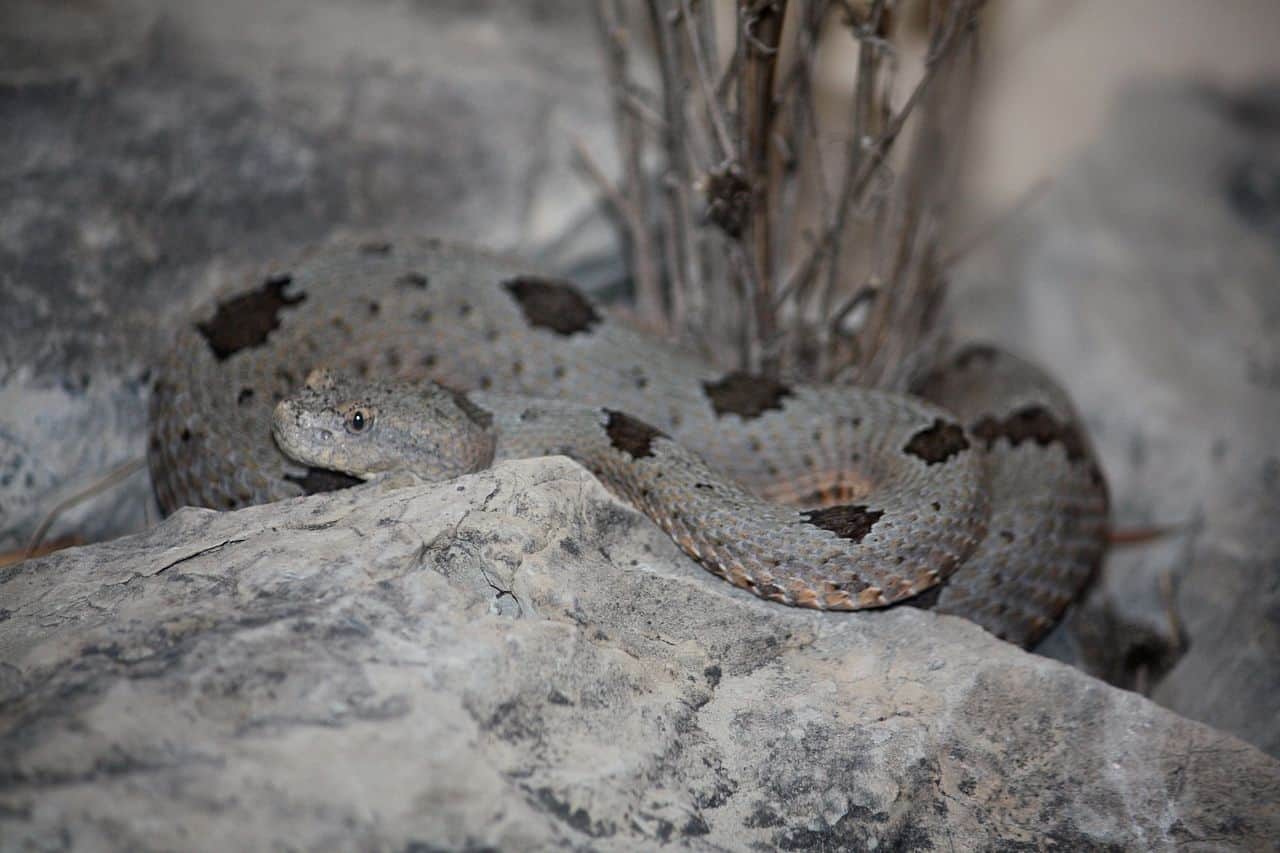
The rock rattlesnake is one of many species in the arid regions of the southern US, as well as northern Mexico. They can be found in Texas, Arizona and New Mexico, and are a fairly short rattlesnake, peaking at 80cm, with an average of 60-70cm.
As ever, this rattlesnake is dangerously venomous, but rock rattlesnakes are also one of the shier US species. The tiger rattlesnake sometimes appears at the edges of sprinkler-fed resorts in Arizona, but rock rattlesnakes live far from prying eyes. They prefer more mountainous arid areas, with an abundance of rocks and dry slopes, but plenty of cacti and shrubs. They’re rarely encountered by people even on remote desert highways, and in front of old wooden porches there’s no chance.
Rock rattlesnakes inhabit the kinds of remote areas where bandits would have sat around a campfire plotting their next robbery 150 years ago. Today, the main group to meet them is extreme hikers. They have a particular reputation for resting on rocky slopes, and their appearance has evolved to blend in with these environments. Rock rattlesnakes are typically a stone grey, with 13-38 bands of darker grey. Their scales are sharp to touch, and they sometimes have small spots between each dark band.
| 2 | Lives nowhere near humans |
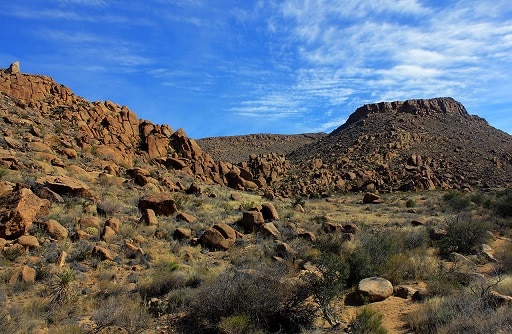
Rock rattlesnakes live at altitudes ranging from 600 metres to 2930 metres in northern Mexico. Rock slopes are one favourite, with endless nooks and crannies they can vanish into. But rock rattlesnakes also live in arroyos directly adjacent to them, arid land which is nevertheless alive with cacti and hardy shrubs.
Rock rattlesnakes live in spots where they can alternate between the two at will, depending on temperature. The more open desert arroyos lose heat rapidly at night, under the clear desert sky. This sends them fleeing for steep slopes as the sun sets, but these rock fields absorb too much sunlight during the day, heating up rapidly and potentially sizzling the snake.
The best time to spot a rock rattlesnake is at sunset or sunrise, as they switch between their two bases. Rock rattlesnakes are also less common on rocky slopes during the summer, for the same reason. Other habitats include the gravelly bases of dried out streams, and rocky slopes within montane conifer forests. In arroyos, rock rattlesnakes are typically found resting beneath thick shrubs, waiting to ambush lizards.
| 3 | One of the lazier rattlesnakes |
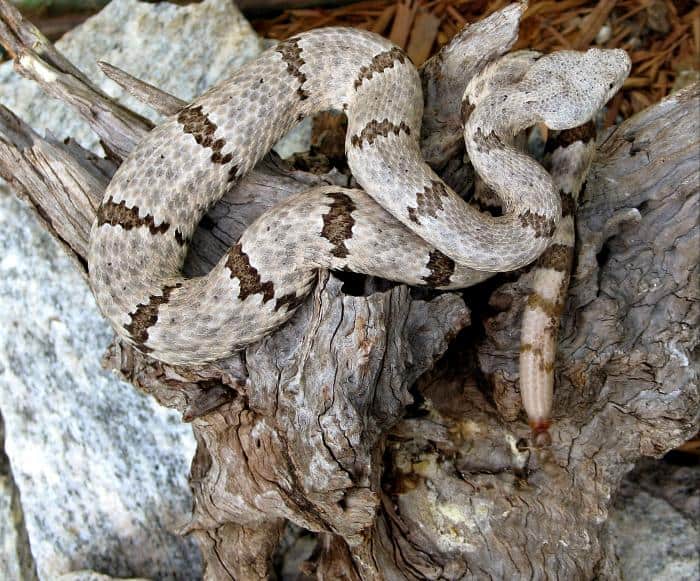
Rock rattlesnakes are one of the lazier members of their family. They move just 10-20 metres per day, which is above the ridge-nosed rattlesnake, but close to bottom for rattlesnakes of the southern US. According to a study from the Chiricahua Mountains of Arizona, they moved less than virtually all other species, including tiger, black-tailed, twin-spotted, west diamondback, and Mojave rattlesnakes. The most active southern US rattlesnake of all is the sidewinder, slithering hundreds of metres per day.
Unlike the prairie rattlesnake, rock rattlesnakes don’t travel miles and miles to their summer feeding grounds. They stick to a single sunny corner of the wilderness all their lives. Rock rattlesnakes can operate in night or darkness, with temperatures being the real key.
By late May, they switch on around dusk, and return to their shelters by 9:30am, to avoid the searing heat. This also means that those at higher altitudes are barely nocturnal at all. Heavy rains tend to bring them out of their shelters, and males are more energetic than females, searching for mates.
Rock rattlesnakes rarely climb trees, but can reach 1.4 metres occasionally. They’re also decent swimmers, despite rarely encountering water.
| 4 | Blends into different rock types |
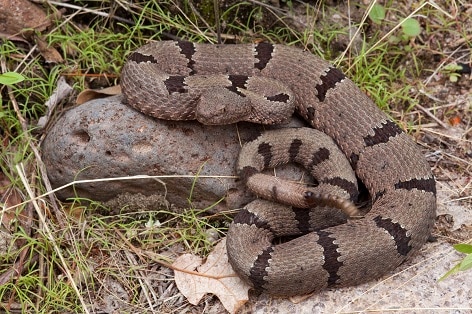
Crotalus lepidus blends into rock, but the problem is that there’s many types of rock. No worries – the rock rattlesnake can shift its superficial scale colour depending on the slope.
Texas is one rock rattlesnake hotspot. A habitat in the western Texas is the Davis Mountains, continuing southwards through to Big Bend. The soils here are more volcanic and darker, and the rock rattlesnakes have thicker, darker blotches. In eastern Texas, a base is the Stockton and Edwards plateaus, which have lighter soils mixed with limestone outcrops. The rock rattlesnakes here have the more typical pattern, grey with faded blue tinges.
These differences happen without being different subspecies. Rock rattlesnakes have an inherent ability to switch their colour to blend in. In 2012, a study showed that the colours vary to disguise themselves against predators. Scientists placed models of rock rattlesnakes over rubbly slopes, painted carefully to match natural morphs. The models consisted of urethane foam, designed to withstand Texas temperatures of 38C. Some matched the rock type, while others didn’t. The misfits were swept down upon by birds far more, as they stuck out like a sore thumb. Another model suffered a worse fate – its head was stomped on and destroyed, either by a deer or sheep.
| 5 | Symptoms: spontaneous bleeding |
The rock rattlesnake has a mainly haemorrhagic venom, with almost no neurotoxins (unlike the tiger rattlesnake). Bites are extremely rare, but one reported in 2005 happened to a snake handler, who received a full two-fanged strike on the left thumb. His thumb became swollen and painful within minutes. Within 5 minutes, the victim had wrapped a rubber tourniquet around the wrist, and started driving himself to the hospital, which he reached one hour post bite. As he strode into the emergency room, his hand was painful and swollen, but his wider body was still spared, except for a heartrate of 103 BPM. The swelling soon reached his wrist, preventing him from touching his thumb and index finger together.
Over the next hour, the swelling reached the victim’s upper arm, and he spoke of a strange feeling that cold water was dripping on his lips and chin. The man was offered antivenom, but refused, allowing just a small dose of morphine.
The man was bed bound for the next 24 hours. The swelling reached his chest and neck, but the systematic systems were mere nausea and vomiting, which could have been caused by the morphine. His arm began to haemorrhage slightly, but not severely enough to cause blood blisters. Nor did the skin turn necrotic and rot. The man was discharged on day 5, and at a checkup one year later, there was no permanent damage to his limb or skin.
| 6 | Venom curiosities |
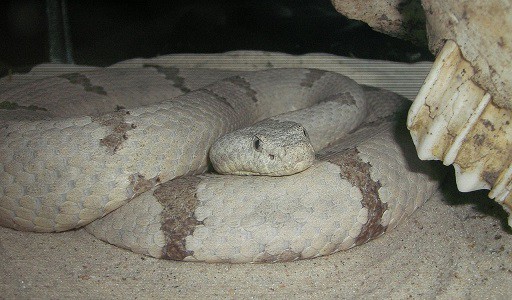
Rock rattlesnakes can cause different symptoms depending on country or even state. There are 4 subspecies, which have been separated by geographical barriers for millions of years. Crotalus lepidus lepidus and C. l. klauberi are the two US subspecies, and are significantly deadlier than the two Mexican versions, Crotalus l. molorus and C. l. maculosus. They cause less local effects like swelling, but significantly more haemorrhaging. A bloodstream biomarker called creatine kinease, an indicator of muscle tissue destruction, was significantly higher with the two US subspecies.
The venoms also affect animals differently. Crotalus l. lepidus was far more toxic towards lizards, with an LD50 venom toxicity score of 0.17mg, The Mexican subspecies only managed 6.68mg, but was significantly more toxic towards crickets. The rock rattlesnake can specialise itself to particular rocky outcrop ecosystems.
Consequently, the exact deadliness of rock rattlesnakes varies wildly in studies, and likewise for the venom yield. One Crotalus lepidus spewed out 129mg in a single bite, but another produced only 24mg, 25mg and 34mg in three separate milkings. This is middling for the rattlesnake family.
| 7 | Their one weakness |
Rock rattlesnakes have weaknesses, as compared to their prairie rattlesnake cousin, they’re poorer at following mammal scents. They find it trickier to latch onto whatever chemicals mice and rats produce, and stalk them through their well-trodden trails. This is because rock rattlesnakes are one of the more heavily reptile-eating rattlesnakes, unlike the prairie rattlesnake, which gets 90% of its meals from mammals.
A 2002 study analysed hundreds of individual rock rattlesnakes. It found the following diet breakdown: 55.4% lizards, 28.3% centipedes, 13.8% mammals, 1.9% birds, and 0.6% fellow snakes. The vast majority of lizards were one species: Jarrow’s spiny lizard, a high altitude species which often skits over rocks in the Chiricahua mountains.
Two of their confirmed snake prey include the Chihuahuan night snake and western hooknose snake. Confirmed mammal prey include the Plain’s pocket gopher, and white-ankled mouse. The rock rattlesnake also has its own predators, including copperheads and collared lizards.
Like its venom, Crotalus lepidus’ diet varies by location. Another study compared two rock rattlesnake habitats in Big Bend, southern Texas. In one, lizards were over 80%, while in the other mammals were over 60%. That said, lizards still averaged out on top.
| 8 | They don’t want to be found! |

As well as living far from prying eyes, rock rattlesnakes are rarely abundant even where they do live. You might find a handful on one desert slope, before beginning the long thirsty march to the next prospective spot. Reynolds examined 40 individual Crotalus lepidus habitats. The most heavily populated contained 106, but only 6 contained more than 7 snakes.
Likewise, a study driving up and down the Chihuahua highway for three years found just 3 rock rattlesnakes, among 418 snakes in total. This is a far cry from the prairie rattlesnake, which has complex social systems and sometimes lives in colonies of over one thousand. The Arizona black rattlesnake is another social species, but rock rattlesnakes are far more solitary.
If you do meet a rock rattlesnake, then you may just escape, as this is one of the calmer, more docile species. They prefer to rely on their supreme camouflage, hiding in a rock crevice. It’s possible to be on a rocky slope, hear a rattle echoing around you, and have no clue where it’s coming from.
| 9 | How mothers hide their young |
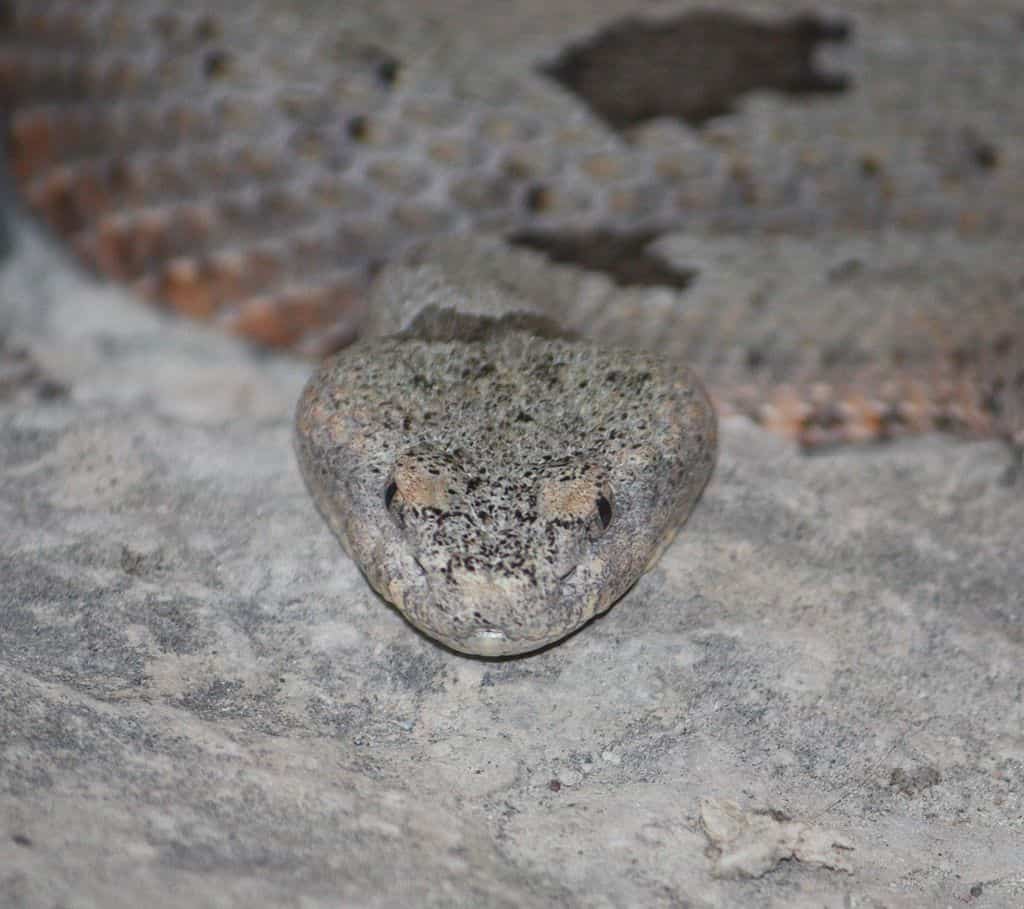
Crotlaus lepidus is another rattlesnake species that guards its young. Mothers know that the species’ future will be imperilled if too many hatchlings are picked off by birds. On the plus side, they have venom, but on the downside, they don’t have any arms or legs.
So rock rattlesnake mothers take advantage of their environment and stash their young in a rocky crevice, before sitting still and guarding the entrance. Rock rattlesnakes lay live young, in low amounts of 2-9. They only reproduce bi-annually, adding up to a low reproductive rate overall, which means that they could become endangered if their habitat is absorbed by humanity.
Rock rattlesnakes enter hibernation in November. They’re intelligent about their spots, resting on rocky slopes, but always choosing those that face south, to maximise sun absorption during the chilly days of winter. Another survival trick is licking droplets of rainwater from natural pools in rock surfaces, or even off their own scales. Rock rattlesnakes have a “least concern” conservation tag from IUCN internationally, but New Mexico’s state government considers them to be threatened.
| 10 | Terrified of kingsnakes |
Rock rattlesnakes actively search for their prey sometimes, but more often ambush them. They rest between rocks or vegetation in a S-shaped coil, with their head resting on the rocks themselves. When a lizard skits along the stony surface, they launch from below, striking multiple times. Rock rattlesnakes hold onto the prey until they enter a coma, not swallowing until they’re immobile. As youths, they have a bright yellow tail tip, which they use to tempt prey. This fades completely to grey by adulthood.
The common kingsnake, AKA Lampropeltis getula, is one of America’s most notorious snake-eating snakes, even able to swallow down venomous copperheads. The news has apparently reached the remote outcrops of rock rattlesnakes, as when scientists placed kingsnake scents in front of them, they immediately acted defensively, placing their head in a shield of coils. When their scent-detecting vomeronasal organs were taped shut, they didn’t react at all.
